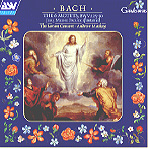No one can truthfully say that Bach’s motets haven’t been treated well on disc–some would say almost too well given the various and near-bewildering combinations of performing styles and points of view represented. Of the 10 recordings I re-visited during this review, none are identical in vocal forces, instrumentation, or even in the program itself. Even the latest scholarship is not firm on the matter of how many and exactly which of these works actually “count” as motets, and there persists some disagreement as to the authorship and classification of Lobet den Herrn, alle Heiden BWV 230. However, it’s reasonable to conclude that Bach did write BWV 230 and that the number of extant, attributable motets is more than the five or six traditionally accepted ones–more likely seven or eight.
This recording focuses on the traditional six–BWV 225-230–but is likely to rankle many listeners with its Joshua Rifkin-inspired one-voice-to-a-part philosophy and the surprisingly unclear, undetailed results it brings in the performances. What’s more, in his liner notes, Sarum Consort director Andrew Mackay cites Rifkin’s “brave” challenges to the status quo in Bach performance, and then rather arrogantly declares that “over the last 20 years Rifkin’s conclusions have come to be accepted as almost certainly correct…”–a provocative yet totally unfounded statement. He further argues that those who oppose the one-to-a-part idea are misguidedly employing more voices in order to provide more volume, and suggests that the laws of acoustics determine that “to double the sound output of four singers requires not eight singers but 32–thus four singers make almost the impact of eight.” Besides the nitpicky absurdity of that way of thinking, any choral director knows that adding a few more singers has nothing to do with volume, but rather with quality of sound, with ensemble and sectional blend. Volume will take care of itself.
So, what do we get with Mackay’s brand of Bach? A handful of really nice voices who together produce ensemble singing of a generally indeterminate number of parts (some of which is a function of murky sound engineering and/or acoustics of the venue), and in which interpretive nuance–articulation, dynamic variation, phrasing, accents–gives very little importance to the language and textual meaning. (Just listen to the one-dynamic, unimaginatively-phrased BWV 226–all three movements exactly the same. Even the opening declamations of Komm, Jesu, komm are astonishingly bland.) After listening for 20 or 30 minutes, you realize that the expressive and sonic differences from one work to the next and between movements are so small as to make it easy to lose track of which motet you’re listening to. Part of the problem is that the only accompaniment (Mackay does subscribe to the well-founded belief that these motets were meant to be accompanied) is a rather colorless chamber organ. And for all the discussion about four or eight voices being enough to balance continuo (and colla parte instruments), this organ often seems to have the upper hand, so to speak.
And speaking of voices, Mackay doesn’t even consistently follow his own explicitly stated performance practice: why, in the four-voice Lobet den Herrn, does he use eight singers? Ironically, this is the best-sounding–full-bodied, cleanly, expressively articulated–of all the works on the disc, and except for the “hah, hah, hah” effect from the tenor and bass singers in the second-movement “Alleluia”, this performance is a winner and gives a hint at what might have been.
If you’re looking for a good alternative to this recording–and you must–you’ll have to make a few decisions regarding program (how “complete” do you want to be?) and performing forces (strings and winds, organ, just continuo, etc.). Among the finest available versions are: René Jacobs and the RIAS-Kammerchor, who offer the “standard six” with small orchestra and continuo of strings and winds (Harmonia Mundi); Frieder Bernius and Kammerchor Stuttgart, who subtract Lobet den Herrn from the basic six and employ a more sizeable orchestra of 10 strings, winds, and organ (Sony Vivarte); Harry Christophers and the Sixteen, who do the basic six with continuo of cello, violone, theorbo, and organ (Hyperion); and for completeists, Helmut Rilling, who with his excellent Gächinger Kantorei and Bach-Collegium Stuttgart (the largest instrumental contingent of the bunch) takes no chances, including everything that could possibly be a Bach motet–10 works in all–on two somewhat bright-sounding but musically uncompromising discs (Hänssler). [5/29/2001]
































